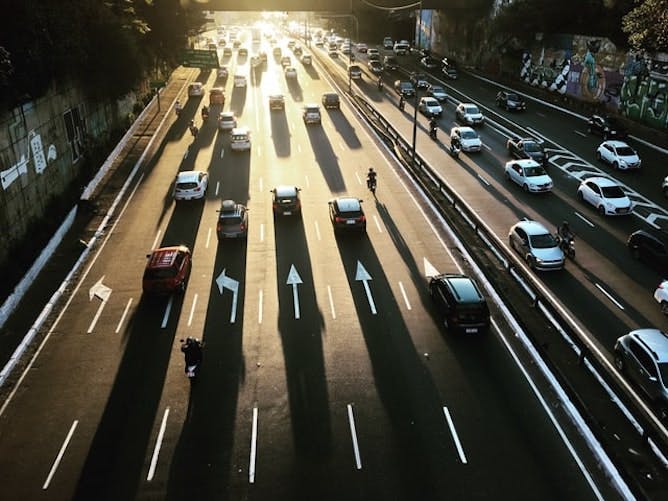
On your driving test, your examiner will be looking closely at your position on the road. Under this section of the mark sheet, there are two areas upon which they’ll be judging you. First: your road positioning. This includes how well you’re centred within your lane, and how you adapt your position when making a turn or overtaking. Secondly, lane discipline, and whether you can successfully choose the correct lane for your destination.
It might seem basic, but steering into the right position lays a good foundation for all your other driving skills. It's only once you've got the hang of this that you'll be able to pull off more complex manoeuvres and show your examiner you really know what's what.
What is the normal driving position?
Generally speaking, good road positioning means you should aim to keep your car in the centre of your lane. We say ‘generally’, because when you’re out and about, you need a dynamic relationship with the roads. As different hazards present themselves, you need to adapt your driving accordingly, and when you’re about to turn or overtake an obstacle, your road position will need to change.
Why is positioning your vehicle in the middle of the lane important?
There are a few reasons why your ideal road position is in the centre of your lane, and not too far to the left or right.
If you drive too closely to the left of the road:
- You are more at risk of hitting potholes. We all know roads where you don’t get the smoothest of rides. But hitting potholes can mean more than a bumpy journey: they can affect your tyres and tracking (how your wheels align with your steering). This impacts your safety, and will also slash your bank balance when you get around to sorting it out.
- You might hit the kerb or verge. Even a small touch of the kerb can cause a big jolt, and if you hit it at speed, you could do some serious damage. You might even end up flipping your car or causing an accident with other drivers.
- It doesn’t allow for pedestrian stumbles. Giving the kerb some clearance provides a little bit of leeway in case a pedestrian trips off the pavement and into the road, or steps off the kerb without properly looking.

Driving too closely to the line on the right presents other risks.
- You aren’t the only one on the road, and when oncoming traffic meets you, you need to remain a safe distance away from them.
- Other drivers interpret your intentions through your road position. If you’re too near to the centre line, they might logically assume you’re planning on turning right. They might try to undertake you, which would put both of you in a dangerous position.
How can I improve my road positioning?
Use the left leg rule
In a right-hand drive, your left leg is pretty much in the middle of your car. If you want your car to be in the middle of your lane, your left leg needs to be in the middle of your lane. So you might find it helpful to imagine you’re walking down the street, rather than driving. As a new driver, you’ll probably have better spatial awareness as a pedestrian than as a driver. If your left leg starts deviating from the centre of the lane, make sure you get it back on track.
Look at where you want to go

Where we look when we’re driving has a big impact on where we drive. You can test this theory by looking to the left or right as you try to walk in a straight line. We bet you have to concentrate quite hard to keep on course!
It’s the same deal in the car: if the path you’re concentrating on is clear, you’ll gravitate towards it. But if there’s an obstacle in your line of vision, you’ll naturally try to avoid it. So, even though you might want to focus your vision on potential hazards, by doing this, you’ll end up veering away from them. That actually puts you in more danger—and can make you weave down the road. Neither your passengers nor your driving examiner will thank you for making them feel nauseous.
To avoid this pitfall, concentrate on the centre of your lane further ahead: this is where you want to drive. That doesn’t mean putting blinkers on; it’s important to remain aware of your surroundings. But it does mean that you’ll stay centred, even when things crop up to your left and right that shouldn’t have a bearing on your road position.
Wait until you're on the bend before turning

It’s tricky trying to judge when to turn the wheel on a bend. Turn too early, and you’ll drift out of your lane; too late and you’ll end up having to turn very sharply to stay on the road.
If there’s a bend in the road, you still need to focus on your own lane. If you’re so caught up watching out for vehicles coming round the bend that your line of vision crosses over to the other side of the road, chances are your car will follow suit. You’ll end up cutting the corner—putting yourself right in the line of fire if you do end up meeting someone.
So, look as far as possible within your lane. Start turning only when you’re on the bend itself—if you can still see it out of your front windscreen, that’s a bit too early.
Road positioning as you turn left
Up until now, we've seen drivers with good road positioning staying in the middle of the lane. This changes slightly when you want to make a left turn. Move slightly more to the left of your lane, so that you're prepared to go round the corner. However, don’t hug the kerb too tightly when you’re turning left; you don't want to clip it with your tyres.
Changing your road positioning when turning right
As you prepare to turn right, you should move towards the right-hand side of your lane. Position yourself just right of the centre line. If the lane is wide enough, this keeps traffic flowing by allowing other vehicles to pass you on the left. It also demonstrates your intentions to other drivers and helps to reinforce the message you’re giving out with your vehicle indicators. It puts you in a better position to turn and stops anyone—particularly vulnerable road users like motorcyclists—from trying to overtake you.
Overtaking

When you need to overtake someone, whether that’s another moving vehicle, a cyclist or a parked car, you need to give them enough space. If the obstacle is on the move, they may change their position at any time, for example to avoid a pothole. You’ll only stay safe if you’re far enough away that they won’t collide with you.
Where you can’t give the obstacle as much space as you’d like, consider your options. Never risk overtaking a moving object (like a lorry or a cyclist) unless there’s plenty of room to do so. With parked vehicles, you can mitigate the risk caused by less space by reducing your speed.
On your test
To excel on your driving test, check that you know the theory, and can put into practice, the following aspects of good road positioning:
- Drive in the centre of your lane
- Move your road position to the left or right as you prepare to turn
- Give obstacles enough room when overtaking them
Lane discipline

Lane discipline has to do with which lane you’re driving in. To maintain good lane discipline, you need to be in the correct lane for your destination, and use a good road position, as we’ve covered above. You should also avoid changing lanes when it's not necessary.
Which lane should I use?
You might have always thought of left and right lanes as ‘slow' and 'fast' lanes. If that’s the case, get it out of your mind straight away! The left lane is the default lane: you should always use it, except for when you’re turning right or there is road signage that says otherwise. The right-hand lane(s)—yes, middle lanes count as well—are for overtaking and turning right.
Middle lane hogging
Middle lane hogging is a classic motorway offence from drivers who don’t have good lane discipline. After overtaking, they fail to move back into the left-hand lane. That causes other vehicles, who want to pass them, to go even further right to avoid undertaking. Changing lanes brings with it an element of risk, and it can also cause tailbacks, with a long line of drivers having to move out in order to overtake the vehicle in question. It’s no wonder, then, that you can be fined if you hog the middle lane.
'Use both lanes' signs

Occasionally, a dual carriageway may encourage you to ‘use both / all lanes’. This helps to keep traffic moving. Don’t be tempted to weave in and out; sometimes drivers do this to try and keep in the lane that appears to be moving more quickly. It rarely makes your journey faster and can slow down the traffic for everyone. Just remember to get in the correct lane in plenty of time if you’re coming up to a junction.
Straddling lanes
Good lane discipline dictates that you should never straddle two lanes. Sometimes drivers do this accidentally, particularly when exiting roundabouts, as there aren’t always clear lines drawn on the road. However, it’s a really dangerous practice, as you risk cutting up other vehicles, or being clipped by cars travelling in either lane.
Junctions

To maintain good lane discipline, you need to know which lane to choose when you come upon junctions. Usually, you will be able to follow the default rules.
Default to the left
- Where there are two lanes on the approach to a junction, you should stick to the left-hand lane if you’re planning on turning left or carrying straight on, and the right lane if you want to turn right.
- If there are three lanes, you should move to the left lane to turn left, use either of the two left lanes for straight on and the right lane for turning right only.
The exception to this is where there are signs or road markings that tell you otherwise.
Signs and road markings
As you approach a junction, there might be a sign indicating which lane is used for turning in a particular direction, and there may also be white arrows on the road. You’ll often see these at bigger roundabouts, where there are lots of exits. It’s important to get into the correct lane early because switching lanes is hazardous. There are lots of factors that could cause problems, from missing vehicles in your blind spot to straddling two lanes as you try to move across.
Sometimes these signs may mean you have to do something different from the norm. For instance, you might be instructed that the left lane is only to be used for left-turning traffic. So, if you want to go straight on, you’d need to move to the right-hand lane.
Always look out for vehicles who are wanting to change lanes as you approach a junction.
What if you're in the wrong lane?

Mistakes do happen, and sometimes good lane discipline goes out the window when you choose the wrong lane at a junction. Upon realising that you’re not where you want to be, the most important thing is to stay calm. It will depend on the specific circumstances as to whether you can switch lanes safely or whether the best thing to do is to go the wrong way and find an appropriate place to pull over and turn around or find a new route.
As a learner driver, get used to saying your decision-making process out loud. For example, “I know I’m in the wrong lane to turn right. I’ve checked in my mirrors and I don’t have space to move into the correct lane before the junction. I’m going to follow the road round to the left and use road signs to guide me back onto the right route.” This will really help in your practical test because going the wrong way won’t automatically cause you to fail. In real life, drivers go the wrong way all the time! Your examiner will really be looking at how well you react to the situation.
On the test
During your practical test, your driving examiner will be looking out for good lane discipline. Specifically, they’ll want to check that you can:
- Keep to one lane unless switching lanes (no straddling)
- Use the left lane as default and the right-hand lane for overtaking and turning right
- Follow signs and get into the correct lane on approach to a junction
- Stay calm if you are in the wrong lane
Subscribe for driving advice, offers & more
We'd love to let you know about our courses, news and offers via email. You may unsubscribe at any time.
Star Genie Limited trading as PassMeFast. Company number 10093359
Copyright © 2024 owned by Star Genie Limited
PassMeFast, Blue Tower, MediaCityUK, Salford, M50 2ST
